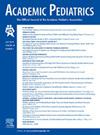Police Avoidance and Depressive Symptoms Among Black Youth
IF 2.8
3区 医学
Q1 PEDIATRICS
引用次数: 0
Abstract
Objective
Police violence is a public health crisis that disproportionately impacts Black youth, worsens their mental health, and potentially heightens their efforts to circumvent police surveillance (ie, police avoidance). Even so, the link between Black youths’ police avoidance and depressive symptoms has yet to be empirically examined. The present study examined this association, adjusting for police violence stress and diverse police exposures. Heterogeneity by youth sex was also assessed.
Methods
Data come from the Survey of Police-Adolescent Contact Experiences (SPACE), a recent, cross-sectional, non-probability survey of Black youth (around 52% male) aged 12–21 in Baltimore City.
Results
Police avoidance was significantly associated with depressive symptoms, above and beyond stress relating to police violence and diverse exposures to police violence (eg, police violence news; direct, witnessed, and/or intrusive police stops). Notably, the association between police avoidance and depressive symptoms was significantly larger among male (v. female) participants.
Conclusions
Findings suggest that Black youths’ police avoidance is an understudied but important factor associated with their depressive symptoms, particularly for young Black males.
黑人青年警察回避与抑郁症状
目的:警察暴力是一种公共卫生危机,对黑人青年的影响不成比例,使他们的心理健康恶化,并可能使他们更加努力地逃避警察的监视(即警察的回避)。即便如此,黑人青年逃避警察和抑郁症状之间的联系还有待实证检验。本研究考察了这种关联,调整了警察暴力压力和不同的警察暴露。还评估了青少年性别的异质性。方法:数据来自最近对巴尔的摩市12-21岁黑人青年(男性约占52%)进行的一项横断面非概率调查——警察-青少年接触经历调查(SPACE)。结果:警察回避与抑郁症状显著相关,超出了与警察暴力和各种警察暴力暴露(例如,警察暴力新闻;直接的,目击的,和/或侵入性的警察拦截)。值得注意的是,在男性(相对于女性)参与者中,警察回避与抑郁症状之间的关联明显更大。结论:研究结果表明,黑人青年的警察回避是与他们的抑郁症状相关的一个未充分研究但重要的因素,特别是对年轻的黑人男性。临床试验注册:无。
本文章由计算机程序翻译,如有差异,请以英文原文为准。
求助全文
约1分钟内获得全文
求助全文
来源期刊

Academic Pediatrics
PEDIATRICS-
CiteScore
4.60
自引率
12.90%
发文量
300
审稿时长
60 days
期刊介绍:
Academic Pediatrics, the official journal of the Academic Pediatric Association, is a peer-reviewed publication whose purpose is to strengthen the research and educational base of academic general pediatrics. The journal provides leadership in pediatric education, research, patient care and advocacy. Content areas include pediatric education, emergency medicine, injury, abuse, behavioral pediatrics, holistic medicine, child health services and health policy,and the environment. The journal provides an active forum for the presentation of pediatric educational research in diverse settings, involving medical students, residents, fellows, and practicing professionals. The journal also emphasizes important research relating to the quality of child health care, health care policy, and the organization of child health services. It also includes systematic reviews of primary care interventions and important methodologic papers to aid research in child health and education.
 求助内容:
求助内容: 应助结果提醒方式:
应助结果提醒方式:


